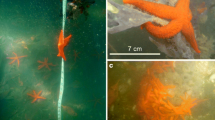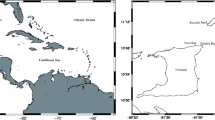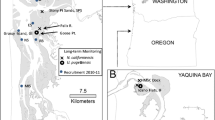Abstract
Recruitment patterns of marine invertebrates are affected both by settlement and early post-settlement events. This study examined the settlement and recruitment patterns of echinoderms at three sites in the rocky subtidal zone of Bocabec Cove, Bay of Fundy, Canada using artificial turf collectors and quadrats on the natural substrate. Potential predators were quantified at two of the sites along transects and in 1-m2 quadrats. Both potential predators and competitors were quantified in 0.0625-m2 quadrats. Settlement varied across sites (1.5–3 km apart) and two years of sampling (2004, 2005). The site of most potential settlement differed for the three groups of echinoderms: sea urchins (Strongylocentrotus droebachiensis), sea stars (Asterias spp.) and sea cucumber (Psolus fabricii). Settlement densities on the artificial turf collectors tended to be greater than the densities of settlers on the natural substrate. On the natural substrate, the only significant difference between densities of juveniles over time was that newly settled sea stars were found in July and were not found the following October. Large lobsters and carnivorous worms were potential predators with densities that varied between sites. Potential competitors that differed in abundance between sites were herbivorous gastropods and conspecifics for sea urchins; and carnivorous worms for sea stars. This study suggests that patterns of recruitment are either set up by patterns of settlement or by events during the first few weeks/months on the benthic substrate for these echinoderms.





Similar content being viewed by others
References
Andrew NL (1991) Changes in subtidal habitat following mass mortality of sea urchins in Botany Bay, New South Wales. Aust J Ecol 16:353–362
Andrew NL, MacDiarmid AB (1991) Interrelations between sea urchins and spiny lobsters in northeastern New Zealand. Mar Ecol Prog Ser 70:211–222
Balch T, Scheibling RE (2000) Temporal and spatial variability in settlement and recruitment of echinoderms in kelp beds and barrens in Nova Scotia. Mar Ecol Prog Ser 205:139–154
Balch T, Scheibling RE, Harris LG, Chester CM, Robinson SMC (1998) Variation in settlement of Strongylocentrotus droebachiensis in the northwest Atlantic: effects of spatial scale and sampling method. In: Mooi R, Telford M (eds) Echinoderms: San Francisco. Balkema, Rotterdam, pp 555–560
Balch T, Hatcher BG, Scheibling RE (1999) A major settlement event associated with minor meteorologic and oceanographic fluctuations. Can J Zool 77:1657–1662
Booth DJ, Brosnan DM (1995) The role of recruitment dynamics in rocky shore and coral reef fish communities. In: Begon M, Fitter AH (eds) Advances in ecological research. Academic Press, San Diego, pp 309–385
Caley MJ, Carr MH, Hixon MA, Hughes TP, Jones GP, Menge BA (1996) Recruitment and the local dynamics of open marine populations. Annu Rev Ecol Syst 27:477–500
Cameron RA, Schroeter SC (1980) Sea urchin recruitment: effect of substrate selection on juvenile distribution. Mar Ecol Prog Ser 2:243–247
Ebert TA (1983) Recruitment in echinoderms. In: Jangoux M, Lawrence JM (eds) Echinoderm studies. AA Balkema, Rotterdam, pp 169–203
Ebert TA, Schroeter SC, Dixon JD, Kalvass P (1994) Settlement patterns of red and purple sea urchins (Strongylocentrotus franciscanus and S. purpuratus) in California, USA. Mar Ecol Prog Ser 111:41–52
Falkner I, Byrne M (2003) Reproduction of Ophiactis resiliens (Echinodermata: Ophiuroidea) in New South Wales with observations on recruitment. Mar Biol 143:459–466
Gosselin LA, Qian P-Y (1997) Juvenile mortality in benthic marine invertebrates. Mar Ecol Prog Ser 146:265–282
Harris LG, Rice B, Nestler EC (1994) Settlement, early survival and growth in a southern gulf of marine population of Strongylocentrotus droebachiensis (Muller). In: David B, Guille A, Feral J-P, Roux M (eds) Echinoderms through time. Balkema, Rotterdam, pp 701–706
Harrold C, Lisin S, Light KH, Tudor S (1991) Isolating settlement from recruitment of sea urchins. J Exp Mar Biol Ecol 147:81–94
Hart MW, Scheibling RE (1988) Heat waves, baby booms, and the destruction of kelp beds by sea urchins. Mar Biol 99:167–176
Hereu B, Zabala M, Linares C, Sala E (2004) Temporal and spatial variability in settlement of the sea urchin Paracentrotus lividus in the NW Mediterranean. Mar Biol 114:1011–1018
Hunt HL, Scheibling RE (1997) Role of early post-settlment mortality in recruitment of benthic marine invertebrates. Mar Ecol Prog Ser 155:269–301
Jennings LB (2006) Effects of settlement and early post-settlement predation on the recruitment of juvenile echinoderms in Bocabec Cove, Bay of Fundy, Canada. Article. Biology, Saint John
Keesing JK, Cartwright CM, Hall KC (1993) Measuring settlement intensity of echinoderms on coral reefs. Mar Biol 117:399–407
Lamare MD, Barker MF (2001) Settlement and recruitment of the New Zealand sea urchin Evechinus chloroicus. Mar Ecol Prog Ser 218:153–166
Lambert DM, Harris LG (2000) Larval settlement of the green sea urchin, Strongylocentrotus droebachiensis, in the southern Gulf of Maine. Invertebr Biol 119:403–409
Latyshev NA, Khardin AS, Kasyanov SP, Ivanova MB (2004) A study on the feeding ecology of chitons using analysis of gut contents and fatty acid markers. J Molluscan Stud 70:225–230
Ling SD, Johnson CR (2009) Population dynamics of an ecologically important range-extender: kelp beds versus sea urchin barrens. Mar Ecol Prog Ser 374:113–125
Lopez S, Turon X, Montero E, Palacin C, Duarte CM, Tarjuelo I (1998) Larval abundance, recruitment and early mortality in Paracentrotus lividus (Echinoidea). Interannual variability and plankton-benthos coupling. Mar Ecol Prog Ser 172:239–251
Lucas JS (1982) Quantitative studies of feeding and nutrition during larval development of the coral reef asteroid Acanthaster planci (L.). J Exp Mar Biol Ecol 65:173–193
McClintock JB, Angus RA, Ho CP, Amsler CD, Baker BJ (2008) Intraspecific agonistic arm-fencing behavior in the Antarctic keystone sea star Odontaster validus influences prey acquisition. Mar Ecol Prog Ser 371:297–300
Milewski I, Lotze HK (2005) Two hundred years of ecosystem change in the outer Bay of Fundy part II—a history of contaminants: sources and potential impacts. In: Wells PG, Harvey J, Percy JA, Daborn GR, Rolston SJ (eds) The Bay of Fundy coastal forum: taking the pulse of the bay. A GPAC-BoFEP coastal forum held May 15–16,2002 as part of the 5th Bay of Fundy Science Workshop. Environment Canada—Atlantic region, occasional report no. 25, Wolfville, Nova Scotia, pp 65–71
Nishizaki MT, Ackerman JD (2007) Juvenile-adult associations in sea urchins (Strongylocentrotus franciscanus and S. droebachiensis): protection from predation and hydrodynamics in S. franciscanus. Mar Biol 151:135–145
Raymond BG, Scheibling RE (1987) Recruitment and growth of the sea urchin Strongylocentrotus droebachiensis (Muller) following mass mortalities off Nova Scotia, Canada. J Exp Mar Biol Ecol 108:31–54
Robinson SMC, Macintyre AD (1997) Aging and growth of the green sea urchin. Bull Aquacult Assoc Can 97:56–60
Rodriguez SR, Ojeda FP, Inestrosa NC (1993) Settlement of benthic marine invertebrates. Mar Ecol Prog Ser 97:193–207
Rowley RJ (1989) Settlement and recruitment of sea urchins (Strongylocentrotus spp.) in a sea urchin barren ground and a kelp bed: are populations regulated by settlement or post-settlement processes? Mar Biol 100:485–494
Rowley RJ (1990) Newly settled sea urchins in a kelp bed and urchin barren ground: a comparison of growth and mortality. Mar Ecol Prog Ser 62:229–240
Scheibling RE (1996) The role of predation in regulating sea urchin populations in eastern Canada. Oceanol Acta 19:421–430
Scheibling RE, Hamm J (1991) Interactions between sea urchins (Strongylocentrotus droebachiensis) and their predators in field and laboratory experiments. Mar Biol 110:105–116
Scheibling RE, Robinson MC (2008) Settlement behaviour and early post-settlement predation of the sea urchin Strongylocentrotus droebachiensis. J Exp Mar Biol Ecol 365:59–66
Strain EMA, Johnson CR (2009) Competition between an invasive urchin and commercially fished abalone: effect on body condition, reproduction and survivorship. Mar Ecol Prog Ser 377:169–182
Tegner MJ, Dayton PK (1981) Population structure, recruitment and mortality of two sea urchins (Strongylocentrotus franciscanus and S. purpuratus) in a kelp forest. Mar Ecol Prog Ser 5:255–268
Tegner MJ, Levin LA (1983) Spiny lobsters and sea urchins: analysis of a predator-prey interaction. J Exp Mar Biol Ecol 73:125–150
Tomas F, Romero J, Turon X (2004) Settlement and recruitment of the sea urchin Paracentrotus lividus in two contrasting habitats in the Mediterranean. Mar Ecol Prog Ser 282:173–184
Underwood AJ (1997) Experiments in ecology. Cambridge University Press, Cambridge
Wing SR, Gibbs MT, Lamare MD (2003) Reproductive sources and sinks within a sea urchin, Evechinus chloroticus, population of a New Zealand fjord. Mar Ecol Prog Ser 248:109–123
Witman JD, Genovese SJ, Bruno JF, McLaughlin JW, Pavlin BI (2003) Massive prey recruitment and the control of rocky subtidal communities on large spatial scales. Ecol Monogr 73:441–462
Acknowledgments
We would like to thank M.-J. Maltais, J. Bowen, P. Emery, B. Morse, S. Corrigan, J. Jones, T. Edgell, B. Williams, A. Bennett, M. Pokorski, M. Sprague and the Navy Island Dive Company, and C. Kenny and the Dive Shack for all their help with the field work. We would also like to thank R. Rochette, B. MacDonald and anonymous reviewers for their comments on various versions of this manuscript. Funding for this project was from an NSERC Discovery grant to H.L.H., and a Vaughan Scholarship and research assistantship from UNB to L.B.J. Experiments done in this study complied with Canadian laws.
Author information
Authors and Affiliations
Corresponding author
Additional information
Communicated by M. Byrne.
Rights and permissions
About this article
Cite this article
Jennings, L.B., Hunt, H.L. Settlement, recruitment and potential predators and competitors of juvenile echinoderms in the rocky subtidal zone. Mar Biol 157, 307–316 (2010). https://doi.org/10.1007/s00227-009-1318-7
Received:
Accepted:
Published:
Issue Date:
DOI: https://doi.org/10.1007/s00227-009-1318-7




